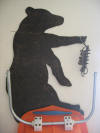|
Click on any picture for a close-up |
|
 |
I used HDPE blocks that I obtained from a
manufacturer in CT. I got them as a free sample, but I don't think this
amount would cost too much. I experimented with electrical conduit u-bolts
on wooden blocks and other such things. I wanted to create traditional
pillow blocks that could handle the torquing of the traces, but these
plastic blocks worked very well. I used a drill press with a bit about 1/16
" bigger than the outer diameter (OD) of the electrical conduit. I then
drilled 4 holes in the corners for attachment bolts. After they were
drilled, I used a band saw to cut the blocks in half so I could remove the
u-conduit (in case of replacement) without taking both blocks off the sled
itself. |
 |
I used a section of electrical conduit for the
foundation of the trace system. You have to take care to make measurements
accurately and make the bends in the conduit exact. The angle of each bend
needs to be the same for the pulk to pull straight. Note I marked a center
line on the conduit before making either bend. |
 |
|
 |
I used nylon collars with stainless set screws
on the outer sides of each block. These collars keep the conduit from
sliding side to side within the blocks. I obtained these collars from an
industrial supply company online (I've since forgotten their name, but some
googling will find a supplier). |
 |
I used some metal plate on the inside of the
sled to keep the blocks from pulling the bolts through the plastic. You
could also use sturdy, large washers, but I thought this would be the most
secure with minor weight increase. |
 |
The trace system is entirely modular. It uses a
series of button springs and pairs of holes. |
 |
In each piece of trace, I drilled pairs of holes
so that I could adjust the length of the trace system according to ski
length, stride, terrain, etc. In practice, I keep them the same length most
of the time. The traces can be adjusted from 60 inches to 8 feet. A
normal setting for me with Fischer Outtabounds is 74 inches. Additionally, this feature is nice for collapsing the pulk to
fit in a car without having separate pieces all over the place. I have no
assembly, and therefore no chance of losing parts. |
 |
I used these spring pins that everyone is
familiar with in each end of the trace sections. It took me a while to track
these down, but I eventually obtained these from the same online supply
house. I think they were called "button springs". |
 |
The waist belt is attached directly to the
traces with pins. |
 |
The waist belt I had came with several
attachment points. Be creative, but you don't want too much play between the
belt and the traces. Some folks talk about some shock-absorption, but I
haven't found the need for it. |
 |
Here is a close-up of the attachment point. |
 |
These are the attachment pins. I don't know what
they are called, but I got them at the local hardware store. They are super
strong and have the attached wire hoop as a keeper. I added the small pins
to the large pins as added security against the pins slipping out of the
traces. They might be overkill. |











